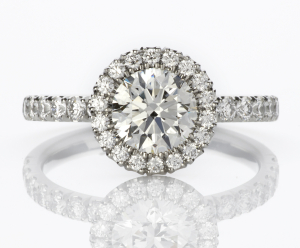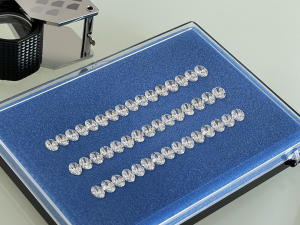How To Choose Quality Diamonds For Your Jewellery Design
Dear Reader,
This editorial is about choosing high-quality diamonds for jewellery designs. When working with diamonds, jewellers and jewellery designers will spend many hours researching, sketching and creating the precious metal setting. Using low-quality diamonds can leave even a well-designed piece falling flat, so it is important to know what to look for when you choose the stones that will feature in your jewellery. In this guide, we explain the different factors to consider when selecting diamonds.
Diamond Quality and the Four ‘C’s: Cut, Clarity, Colour, Carat
It is common to advise jewellers on the four markers of diamond quality, known as the Four ‘C’s. These are Cut, Clarity, Colour and Carat, and are metrics used globally in diamond valuation to ensure comparable standards throughout the industry.
When choosing diamonds to suit a particular design, consider these metrics as a starting point.
Cut
A design may call for a specific cut, such as a round brilliant or emerald cut. However, the precision of the cut is also crucial. Precision diamond cutting techniques used by quality suppliers mean jewellers and designers can set tight parameters.
In some cases, a design calls for a custom diamond cut to achieve a certain shape or appearance. Pala Diamonds cut diamond assortments to a minimal tolerance allowance of <0.07mm. A discrepancy more significant than this can make a big difference to the jewellery manufacturing process, increasing the cost and time required to set the stones.
Clarity
Natural diamonds almost always contain inclusions, which are traces of minerals or uncrystallised carbon that appear within the crystal structure. The clarity of a diamond refers to the severity or quantity of inclusions and is rated on a scale of from FL (internally and externally flawless) to I (included).
Flawless diamonds are very rare and not often available. Even inclusions that are not visible to the naked eye can affect how light passes through the diamond, so the size, shape and position of each inclusion are recorded to scale in grading reports for stones above 1ct.
Pala Diamonds focus on clarity and minimal rejection. Our wholesale assortments below 1ct offer diamonds in clean VVS, or very very slightly included, to commercial SI, or slightly included. This means our assortments contain diamonds of consistent clarity and high quality, carefully assorted to international laboratory standards.
To a certain extent, inclusions may be masked by the cut and colour of the diamond, so it is important to balance these factors when considering options.
Colour
Diamond colour can vary from colourless to yellow or brown. The 23 different shades of diamonds are rated from D (colourless) to Z (faint yellow). Diamonds of other, deeper colours are known as ‘Fancy coloured’.
Purely colourless or white diamonds (D-E) are rarer than those with a warmer hue, and a diamond graded G or higher is referred to as ‘near colourless’.
It is worth noting that the colour appearance of a diamond may differ when set, and possibly be brighter if the diamond has excellent light return due to fine cut. Consider the colours of the metals your design includes when setting requirements for diamond colour.
Carat
A diamond carat is a unit of weight. Each diamond carat is equal to 200 milligrams (0.200g). Measuring the weight to the 100th decimal place ensures complete accuracy.
Diamond value is based on a balance of these factors, meaning none of these can be viewed in isolation.
Uniformity of Diamonds

In every piece or line of jewellery, the diamonds used should match one another well. This is especially true when working with many small stones, as discrepancies can diminish the overall appearance of the finished piece. Uniformity and regularity in a line of diamonds offer many benefits.
- The setting process is more efficient, particularly when working with CNC machines or other automation. Using diamonds of the same size and shape reduces the need for recalibration.
- The final piece has a refined overall appearance when the stones are well-matched and regular, ensuring an even reflection of light.
Diamond Size, Proportion and Light Refraction
Each design will require a particular size of diamond to achieve the desired effect. Just as the precious metal settings will be manufactured to exact dimensions, the line of diamonds should fit perfectly. If using varied sizes, ensuring they are proportional will result in a balanced appearance.
It is also important to consider the proportions of the individual diamonds in the line you choose.
- Depth is the measurement from the table to the culet, the lowest point.
- Table size is a percentage ratio of the width of the uppermost surface of the diamond (the table) to the total width.
- Width is the diameter at the widest point, known as the girdle
- Crown height refers to the height from the girdle to the table. This is sometimes given as a percentage ratio, comparing the crown height to the total depth.
- Pavillion Depth is the distance between the girdle and the lowest point or culet.
Other measurements include girdle thickness, star length, crown angle, and pavilion angle. It’s important to pay attention to the relationship between these measurements, as they can greatly impact how light is refracted and reflected within the stone. For example, a shallow pavilion can distort reflected light and diminish the appearance of sparkle.
The proportions you select will ultimately depend on the appearance and effect you want to achieve. Our precision diamond-cutting services ensure particular attention to depth, girdle, table and crown height percentages to achieve uniformity of proportion across our lines.
Jewellery Design can Shine with Diamond Quality Experts
This is an initial guide to selecting diamond lines for a jewellery design. Diamond quality assurance and valuation are complex processes, and we are happy to explain further any of the factors mentioned here. In the coming months, we will expand on these discussions to create detailed diamond education resources to support our clients.
When you purchase assorted wholesale diamonds from Pala Diamonds, we pay particular attention to the needs of the design. Together with your jewellery designers, we can advise on feasibility, suggest an appropriate cut and discuss how diamond quality will impact and be impacted by the suggested setting. To book an appointment or discuss our capabilities, speak to a diamond expert at Pala Diamonds.
